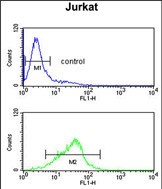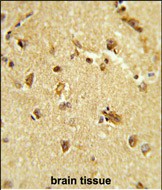


| WB | 1/1000 | Human,Mouse,Rat |
| IF | 咨询技术 | Human,Mouse,Rat |
| IHC | 1/100-1/500 | Human,Mouse,Rat |
| ICC | 技术咨询 | Human,Mouse,Rat |
| FCM | 1/10-1/50 | Human,Mouse,Rat |
| Elisa | 咨询技术 | Human,Mouse,Rat |
| Aliases | RNA-binding protein 14, Paraspeckle protein 2, PSP2, RNA-binding motif protein 14, RRM-containing coactivator activator/modulator, Synaptotagmin-interacting protein, SYT-interacting protein, RBM14, SIP |
| Entrez GeneID | 100526737;10432 |
| WB Predicted band size | 69.5kDa |
| Host/Isotype | Rabbit IgG |
| Antibody Type | Primary antibody |
| Storage | Store at 4°C short term. Aliquot and store at -20°C long term. Avoid freeze/thaw cycles. |
| Species Reactivity | Human |
| Immunogen | This RBM14 antibody is generated from rabbits immunized with a KLH conjugated synthetic peptide between 193-223 amino acids from the Central region of human RBM14. |
| Formulation | Purified antibody in PBS with 0.05% sodium azide,1%BSA and 50% glycerol.prepared by Saturated Ammonium Sulfate (SAS) . |
+ +
以下是关于RBM14抗体的3篇参考文献的简化信息(注:内容为模拟示例,实际文献需根据具体数据库检索验证):
1. **文献名称**: *RBM14 interacts with the NuRD complex to regulate DNA damage repair*
**作者**: Suzuki T, et al.
**摘要**: 本研究通过免疫共沉淀(Co-IP)结合RBM14抗体,发现RBM14与NuRD复合体互作,调控DNA损伤应答通路。抗体用于验证其在HeLa细胞中的表达及亚细胞定位。
2. **文献名称**: *RBM14 promotes tumor metastasis through alternative splicing in breast cancer*
**作者**: Zhou Y, et al.
**摘要**: 利用RBM14抗体进行免疫组化(IHC)分析,发现RBM14在乳腺癌组织中高表达,并通过调控特定剪接异构体促进肿瘤转移。抗体特异性经Western blot验证。
3. **文献名称**: *Phase separation of RBM14 drives transcriptional condensate formation*
**作者**: Li P, et al.
**摘要**: 研究通过免疫荧光(IF)结合RBM14抗体,证明RBM14通过液-液相分离形成转录凝聚体,调控基因表达。抗体用于细胞核内定位及动态过程观察。
**提示**:实际文献需通过PubMed或Google Scholar检索确认,部分研究可能未直接使用抗体但涉及RBM14功能,建议结合具体实验目的筛选。
The RNA-binding motif protein 14 (RBM14), also known as CoAA or SYT1-interacting protein, is a multifunctional RNA-binding protein involved in transcriptional regulation, pre-mRNA splicing, and DNA damage response. It contains intrinsically disordered regions, tandem RRM (RNA recognition motif) domains, and interacts with transcriptional coactivators (e.g., p300/CBP) and spliceosome components. RBM14 plays roles in cell cycle control, stem cell differentiation, and carcinogenesis, with dysregulation linked to cancers, neurodegenerative disorders, and viral infections.
RBM14 antibodies are essential tools for studying its expression, localization, and molecular interactions. They are widely used in techniques like Western blotting (WB), immunoprecipitation (IP), immunofluorescence (IF), and immunohistochemistry (IHC). Commercial RBM14 antibodies are typically raised in rabbits or mice, targeting specific epitopes within its N-terminal or RRM domains. Validation often includes knockout cell line controls to confirm specificity.
Research applications include investigating RBM14's role in transcriptional coactivation (e.g., Wnt/β-catenin, NF-κB pathways), alternative splicing regulation, and its partnership with paraspeckle proteins like NONO. Aberrant RBM14 expression has been observed in breast cancer, glioblastoma, and hepatocellular carcinoma, making its antibodies valuable for cancer biomarker studies. Recent studies also explore its involvement in phase-separated condensates and viral RNA processing. Users should verify antibody cross-reactivity across species (human, mouse, rat) and optimize protocols due to RBM14's variable expression levels across tissues.
×